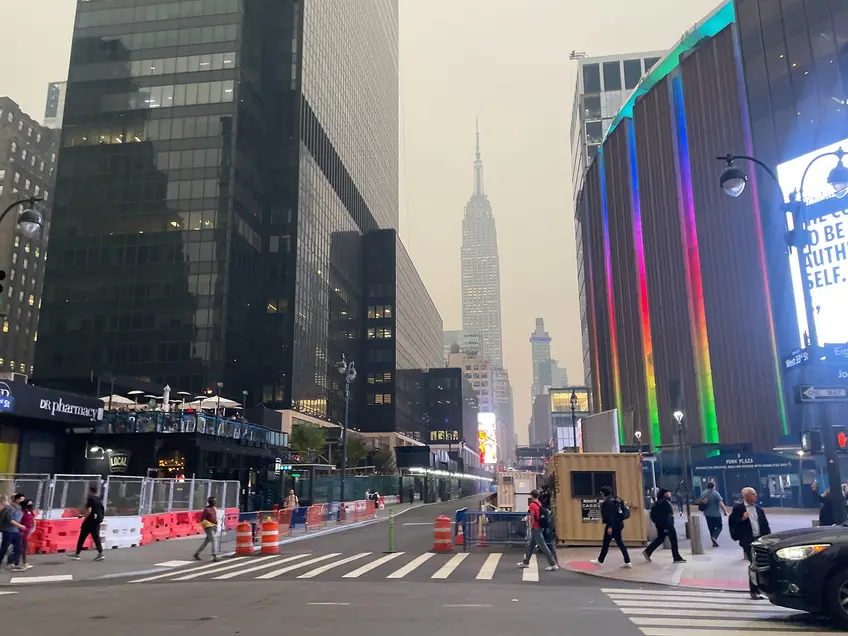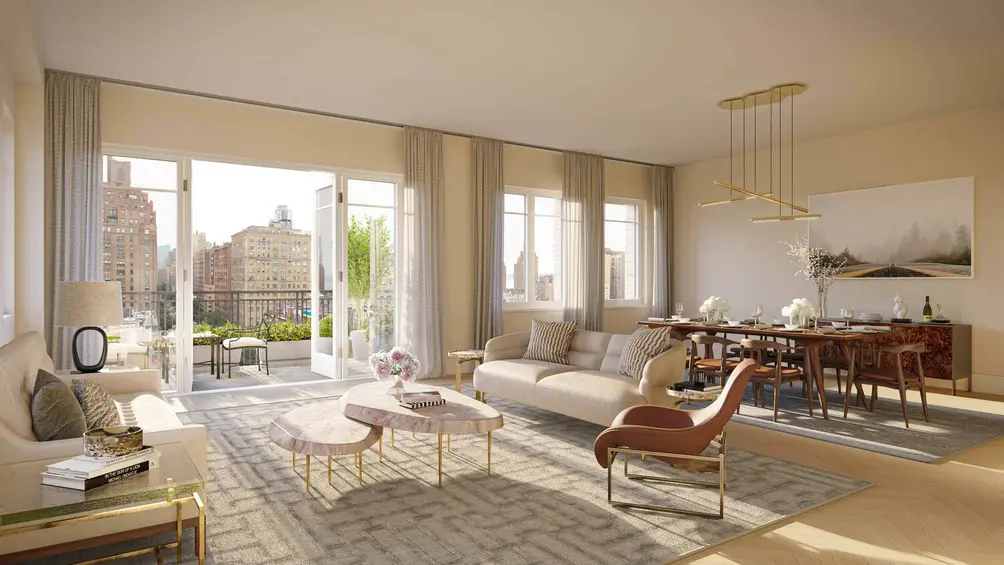 The world's most famous skyline through a haze of smoke (Ondel Hylton)
The world's most famous skyline through a haze of smoke (Ondel Hylton)
In June 2023, New York City experienced its worst air quality day on record. While the poor air quality was mostly noticeable outside, it also lowered air quality inside. Thanks to advanced air filtration systems, however, some local residences fared better than others. This article explores how to find residential buildings with high indoor air quality and how to control the air quality in conventional buildings.
 Living room at 378 West End Avenue, a building known for its advanced air filtering systems (Compass)
Living room at 378 West End Avenue, a building known for its advanced air filtering systems (Compass)
Look for a LEED Certified or Passive House Building
Buildings pursuing LEED certification must meet minimum indoor air quality requirements, which includes meeting standards for maintaining ventilation systems. In addition, it is possible to get up to two LEED credits for indoor air quality. As a result, if you’re looking for a residence with higher than average indoor air-quality, buying or renting in a LEED-certified building is a good place to start your search, but it isn’t the only option.Passive House buildings also typically feature higher air quality than conventional buildings and there is evidence that they may perform especially well during bush and forest fires. An Australian study, which compared air quality levels in a Passive House and conventional home during a bushfire event in Melbourne, found that smoke concentrations were approximately 30% lower in the Passive House. The finding isn’t surprising. Passive Houses reduce outdoor smoke from seeping indoors through a combination of airtightness and mechanical filtration.
However, even in Passive House buildings, the type of filtration system matters. In order to reduce, if not eliminate, the seepage of outdoor smoke into a passive house building, it is important to install a filtration system with a high MERV rating. Better yet, the building should be equipped with a HEPA filtration system, which is the same type of air filtration typically found in hospitals.
 Quite a bit for smog-eating buildings to dine on here! (New York City, June 2023 - Ondel Hylton)
Quite a bit for smog-eating buildings to dine on here! (New York City, June 2023 - Ondel Hylton)
Smog-eating construction
Despite ambitious attempts to lower emissions, air quality is expected to become a growing problem over the coming decade in New York City and globally. With this grim prediction in mind, architects and building engineers are not only actively exploring how to build residences designed to keep bad air out but also how to purify the outdoor air surrounding buildings.In 2016, Architectural Digest published an article about Beijing’s smog-eating tower, a 23-foot high structure that uses ion technology to attract up to 30,000 cubic meters of pollution per hour. Although skeptics have noted that erecting smog-eating towers in highly polluted urban areas may be a bit like attempting to use an air conditioner to cool down a house without a roof, Beijing’s smog-eating tower, the brainchild of Dutch artist Daan Roosegaarde, continues to garner considerable attention. And, true to the environmental ethos of the project, Roosegaarde doesn’t let anything go to waste. The pollution particles collected by the tower were compressed and turned into smog free jewelry that is now on display in museums all over the world.
While cleaning the air by erecting hundreds of smog-eating towers may not be a viable solution, constructing new buildings using smog-eating materials could make a difference. On this account, there are two approaches that seem to hold particular promise.
First, there is the use of smog-eating concrete, a graphene-titania composite that can be used to coat different surfaces, including buildings. The concrete has been found to degrade up to 70 percent of harmful pollutants in the local environment. Another option takes the form of air purifying shingles, which use sunlight to purify polluted air. As explained by 3M, which manufactures a line of air purifying singles, “When sunlight hits the shingles, the sun’s ultraviolet rays transform pollutants—such as nitrogen oxide gases—into a plant-usable form of nitrogen that washes away.” If one or both of these solutions are either widely adopted in newly constructed buildings and other public infrastructure products (e.g., roads and bridges), it is possible that the city itself may eventually consume at least a portion of the smog it currently generates.
First, there is the use of smog-eating concrete, a graphene-titania composite that can be used to coat different surfaces, including buildings. The concrete has been found to degrade up to 70 percent of harmful pollutants in the local environment. Another option takes the form of air purifying shingles, which use sunlight to purify polluted air. As explained by 3M, which manufactures a line of air purifying singles, “When sunlight hits the shingles, the sun’s ultraviolet rays transform pollutants—such as nitrogen oxide gases—into a plant-usable form of nitrogen that washes away.” If one or both of these solutions are either widely adopted in newly constructed buildings and other public infrastructure products (e.g., roads and bridges), it is possible that the city itself may eventually consume at least a portion of the smog it currently generates.
Managing indoor air quality in conventional buildings
If buying or renting in a LEED-certified, Passive House, or smog-eating building isn’t possible, there are still a few precautions you can take when (sadly, no longer a question of if) New York faces its next air quality red alert.First, close all your windows. Fresh air is usually desirable but not during an air quality alert. Second, buy one or more air purifiers for your home. Costing as little as $100, a high-quality air purifier should filter out most allergens, bacteria, viruses, and smoke that enters your home. Third, with all your windows closed, there are also a few activities you should avoid, including lighting candles or incense to block the odors, vacuuming (which can stir up particles in the home), or overuse of your gas burner. In fact, if you can, avoid using your gas stove at all when all your windows are closed, as gas burners have been found to emit fine particulates that can exacerbate respiratory problems.

Contributing Writer
Cait Etherington
Cait Etherington has over twenty years of experience working as a journalist and communications consultant. Her articles and reviews have been published in newspapers and magazines across the United States and internationally. An experienced financial writer, Cait is committed to exposing the human side of stories about contemporary business, banking and workplace relations. She also enjoys writing about trends, lifestyles and real estate in New York City where she lives with her family in a cozy apartment on the twentieth floor of a Manhattan high rise.

 6sqft delivers the latest on real estate, architecture, and design, straight from New York City.
6sqft delivers the latest on real estate, architecture, and design, straight from New York City.
